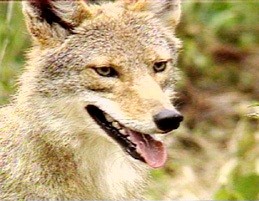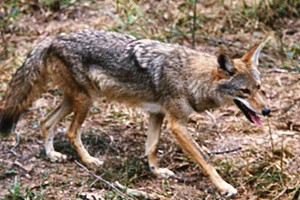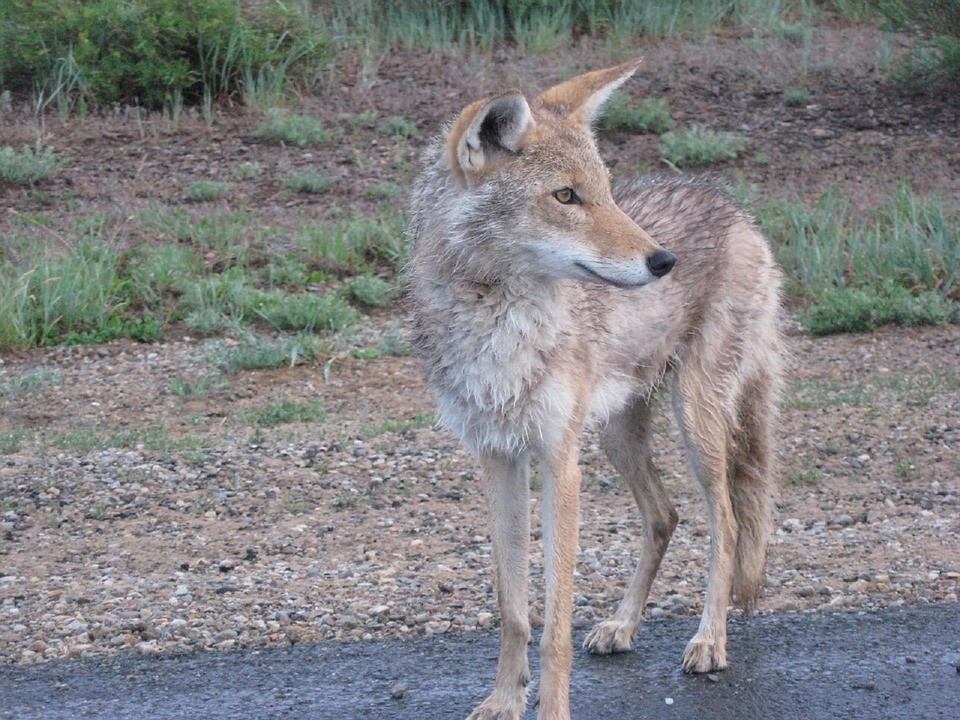Coyotes, Canis latrans
Coyotes are very adaptable, secretive canines that occur in a diversity of habitats all across the state. They are dog-like in appearance and somewhat resemble a small German Shephard.
Description: A large mammal with an elongated muzzle with a black nose, long legs, and a long, well-furred tail with a black tip that is carried down as it runs. Ears are erect and triangular-shaped.
The long, thick, heavy, coarse fur is variable, but usually light gray to dull yellow with the outer hairs tipped with black. The backs of the ears and the outer leg color are typically reddish.
A grey-black band of longer hair (typically five inches long) runs down the mid-back and forms a shoulder saddle or mane. Throat, belly, and under tail color is white.
The eyes are typically yellow or amber with round black pupils. Their eyesight is six times greater than men. Sense of smell is extremely well developed, more than 23 times better than men.
Coyotes rely upon their sense of smell for hunting and detecting scent left by other coyotes. The coyote may run up to 30 mph for short distances. They are good swimmers; however, coyotes are poor climbers
.Coyote tracks are oval in shape and the toenail marks tend to hook inwards. Dog tracks are more round and have deeper nail marks pointed outward. As typical with all members of the dog family, the coyote’s front foot is larger than the hindfoot. The front foot track of the coyote averages 2 ½ inches in length.
Coyote droppings (scats) are quite variable but are typically large, strongly tapered and contain much hair, bones, feathers or seeds.
Length: 39.5 - 54 inches
Tail: 10.8 - 16 inches
Ears: 4 - 4.8 inches
Weight: 18 - 30 pounds
Similar Species: Red and Gray Foxes are smaller, have longer tails, and have vertical slits for pupils.
Some domestic dog breeds may be very similar to coyotes.
Habitat: Coyotes are found in many different habitats. They can live almost anywhere including fields, forests, farmlands, shrubland, and urban areas.
Dens are usually located in remote or unused fields, often in a bank, under a hollow log, in a rock cavity, or under a deserted building.
Diet: Small mammals and rabbits compose a majority of their diet, but they eat a variety of other animal foods. Some plant matter, such as fruit, also eaten.
Breeding information: Breeding usually takes place in February and March when the females are receptive.
Gestation lasts 58-63 days. Females produce between 2-19 (usually 5-7) pups in a litter.
Young are born with brownish-gray hair but are blind and helpless.
They begin to open their eyes around 8 days and learn to hunt between 8 and 12 weeks old. Both adults help care for the young.
Status in Tennessee: Coyotes are locally common due to their adaptability. They are hunted to control their damage to livestock and poultry and for their fur pelts.

Dealing With Coyotes
- Do not feed coyotes!! When coyotes begin associating humans with the food they lose their natural fears and may become dangerous.
- Eliminate water sources. These areas attract rodents, birds, and snakes which the coyote will prey upon.
- Position bird feeders so coyotes can not get to the feed. Coyotes may also be attracted to birds and small mammals that have been lured in by the feeder.
- Do not discard edible garbage. Coyotes are opportunistic and will eat any table scraps.
- Secure garbage containers. Use trash barrels with lids that clamp down tight even when tipped over.
- Do not place trash cans out the night before scheduled pick-up. Placing cans out in the morning before pick-up will give coyotes less time to scavenge. They will not have the cover of darkness.
- Do not leave barbecue grill outside and uncovered. The smell of the grill and the contents of the grills drip pan attracts coyotes.
- Feed pets indoors whenever possible. Remove any leftovers if feeding outdoors. Store pet food in areas not accessible to other animals.
- Clear brush and weeds from around property. This deprives the coyote's prey (small mammals and birds) of the protective cover and deters coyote from hunting around your property.
- A fenced yard may deter coyotes. The fence must be at least 6 feet high. Preferably the bottom of the fence should extend 6 inches below ground level.
- Do not leave small children outside alone if coyotes have been frequenting the area.
- Do not allow pets to run free. Provide secure housing especially at night. Small pets (cats, rabbits, small dogs) are favorite prey of coyotes.
- Discourage coyotes from frequenting your area. Harass them by throwing rocks, shouting, and making loud noises when one is seen.
- Learn more here: Coyote Control

Life History
A typical group of coyotes consists of a mating pair and their offspring. The family unit is largest in the summer when pups, parents, and non-breeding adults are together at dens. Coyotes breed from January through March. Daytime activity increases during the coyote's breeding season.
After the breeding season, coyotes begin a frenzy of feeding activity and begin searching for suitable denning sites. Coyotes may dig their own den or enlarge another animal's den. Natural holes, blown down trees or rocky ledges may also be den locations.
The typical litter size is 5-6 pups born 60-63 days after breeding. The entire family unit including the mother, father, and other family members help raise the young by providing food. The young are weaned after 5-7 weeks. Young coyotes begin dispersal in October, at which point a young coyote may travel up to 100 miles from its birthplace.
Coyotes are chiefly nocturnal but may be active by day. Coyotes communicate through a series of yips, barks, and howls. A common call of the coyote is two short barks and a long wavering yodel known as the howl.
They use stumps, posts, bushes, or rocks as “scent posts” on which they urinate and defecate, this marks the animal's territory and communicates with other animals. Adult males have large territories (15-25 square miles) in which they roam; adult females occupy areas of six to ten square miles. The availability of food affects the territory size of the coyote.
The adaptable coyote may eat almost anything. They prefer fresh kills but will eat carrion. Some of the most important foods to the coyote are rodents, rabbits, insects, watermelons, apples, persimmons, muskrats, squirrels, skunks, and domestic fowl.
Major Differences Between Coyotes & Dogs
- The coyote is similar in size to a small to medium German Shepherd.
- Coyotes carry their tails quite differently than domestic dogs. A coyote's tail is typically held down, although not between the animal's legs. Dogs usually carry their tails in the air.
- An adult coyote track is approximately 2 1/2 inches in length. The track is shaped like an oval, and the toenails are close together and hook inward. A dog's track is round in shape and the toenails tend to point outward. The walking stride ranges from 12 to 15 inches apart. When running, the stride made be anywhere from 3 to 10 feet apart.
Hunting Season
Coyotes may be hunted year-round in Tennessee. There is no bag limit.
Diseases
Coyotes are susceptible to a variety of diseases including rabies, mange, distemper, parvo enteritis, hepatitis, and internal parasites. External parasites including lice, mites, fleas, and ticks also afflict coyotes.
In other states, coyotes have become human health concerns because they are reservoir hosts of rabies. Coyotes are not reservoir hosts of rabies in Tennessee.
Find Wildlife Damage Help - Tennessee Code Annotated 70-4-115 states in part that, the owner of lands may destroy any wild animals, wild birds, or wildfowl when such wild animals, wild birds, or wildfowl are destroying property upon such lands.
